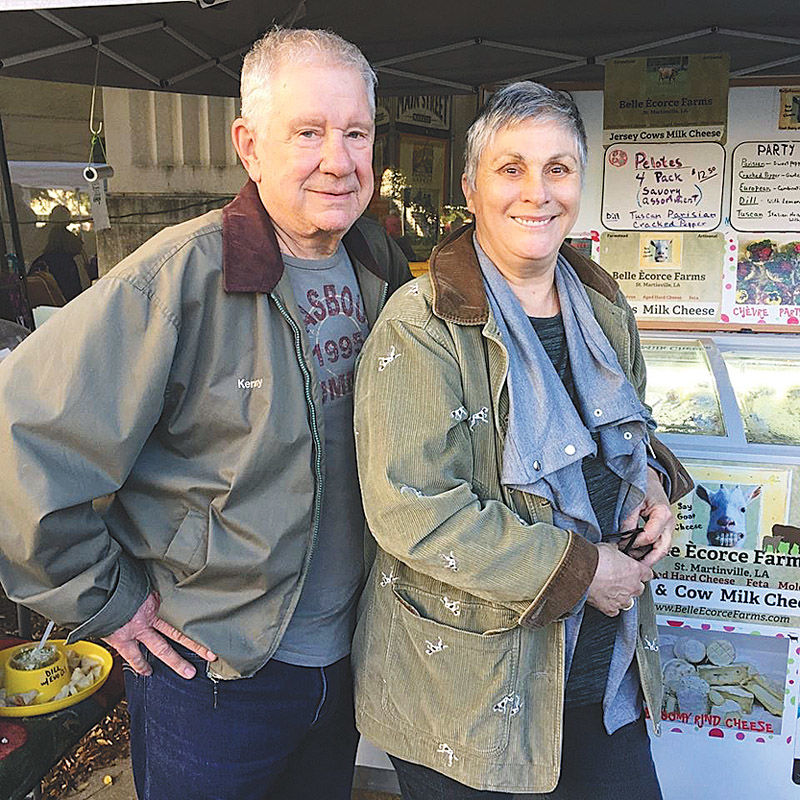Growing the culture for eating — and making cheese
Published 7:00 am Wednesday, July 31, 2019

- Ken and Wanda Barras sell directly to customers monthly at the Baton Rouge Farmer’s Market.
A trip to Belle Écorce, the little farm on the Bayou Teche, was well overdue. The name of the farm or the farmer was unknown in the vague references made to this writer during the past four years exploring food in the Teche Area. Hearing rumors about a “Goat Lady” — a woman who raises goats and makes cheeses in St. Martinville — was untraceable until A Spot for Tea opened on Main Street in downtown New Iberia. Buying the first soft-spread Fig Preserves Chévres made a fan of this cheese-lover that grew up mostly exposed to processed cheddar cheeses, only recently experimenting with the vast array of gourmet varieties. After a visit with the artisanal farmer, more questions remain but a greater appreciation for the craft of hand-made cheeses brings this Q&A to life. Which, by the way, is how Wanda Barras refers to cheese — it is living. Considering the time it takes to perfect the process, the variation on tastes, depending on the curing process and the ability to rescue a moldy cheese, gives way to a totally new understanding of the milk-based products. In this instance, both cow and goat milk is used. Cultures are a part of the cheese making process, but appreciation for degrees of crafted cheese — which can get rather pricey, like a fine wine — requires growing or cultivating an audience of palate-pleasing-experimentors willing to try something new. The sampling has just begun for this cheese consumer.
Do you have enough figs to make that spread all year long?
That’s a very popular one. My sister’s father-in-law who’s 98 makes the fig preserves. I don’t know anyone that makes them as good as those are, it’s probably the amount of sugar in them. Plus they have big fig trees. So far, I’ve managed to keep that in stock.
Is this farm where you were raised?
My grandfather was born in 1880 and he bought this farm in the late 1940s. After my father got out of the service, more in the Korean War time, we moved here with his father. Daddy was the youngest child. It was a great place to grow up. I remember watering those big oak trees he planted along the road. It was in the country then, but it’s not any more. It was my grandfather’s retirement place, Luel Broussard. Dad was called AP Broussard, of the Broussards from Loreauville. We’re direct descendants of Beausoleil. Marcelle Bienvenu is my first cousin and comes to get cheese here all the time.
Your website has an assortment of animals that you raise and sell. What is all that about?
I started with baby birds, and mostly equipment for them, shipping it all over the U.S. I was involved with bird breeding & avian pediatrics more than 30 years, lovable hand-fed baby parrots and macaws.
How did you start with the goats?
In 1999, I went with my neighbor to get goats for her husband to raise. I bought two and was milking my goats on the porch like EllieMae (Clampet). Then my husband, who is an oil field contractor, built me this building. We turned it into stables and a place to make my cheese. My grandson started with a cow in 4-H and I make feta from that, everything else is from the goat’s milk. The goats were pets. They had babies and I bottle fed the babies. Before I started I went to the grocery store to taste goat’s milk, but I didn’t like it. Goat’s milk is very delicate, nice and fresh — under five days old it’s comparable to cow milk. It’s very white. It’s naturally homogenized. I use it all to make cheese. It’s very good fresh, but different in the store. Usually you have goat cheese between Easter and All Saints Day, that’s when they are not breeding. Cows you can milk all year long.
What is chévre verses Gouda?
Chévre is like cream cheese, it is the base for the flavored cheese spreads. I do some sweet and some savory. The Gouda recipe is the base for another cheese I like to make, I do my own thing. The reason I do a Gouda and not a cheddar is because of the size vat I have, it is easier. There’s a really long process for cheddar and it takes cutting the cheese and in my size vat its too hard. I prefer the Gouda, it’s softer and gives me more working room. Sometimes I put beer in it, a hops, like Abita Pecan beer. I like that, but it’s seasonal. I’m messing with the herbs now. I do my own thing with it. Some are two years old and stronger.
What is the difference in the cheese process?
With the Brie and white mold cheeses, it ages from the inside out, you don’t want to leave it too long. It’s stronger, and is a different cheese. Some people like a strong taste, others like a milder taste. Some come asking for the stinkiest cheese I have, that’s the older cheese. I tell customers if they take it home and don’t like it, come back. If they say they want a strong cheese and I give them one, it’s not like grocery store cheeses. Some say, “I like any cheese,” but you give them a strong cheese and they don’t like “any” cheese.
What are some of the ways you describe the different cheeses?
This one’s strong, or it has a bite to it, one’s stronger, mild or a good after taste, I talk to find out what they like. Some age with a bite, some age and are milder. The humidity matters. The customers that like the strong stuff, like the stinky. I vacuum pack to take it to the market otherwise I leave the cheese to breathe.
What is the shelf life of the spreads?
They last a long time or you can freeze it. If savory, use olive oil. The fig can go sour, but it’s not going to kill you. Cheese is a living thing, it changes. It may change to a point you don’t like it, but it’s just changing. You can just cut off the mold of harder cheeses if you don’t like it. I’ll taste it and if I like it I’ll eat it, otherwise just throw it away. Unless it’s really gross. Cheese is a living thing and it could change so you don’t like it, but somebody else might like it. It doesn’t go bad. It keeps several weeks, it might get tart, but just taste it. The four flavor sampler and other soft spreads are packed in olive oil. The thing is to fill it to the top and cover it with oil but not too full.
What else about your cheese?
A lot of people who can’t drink cow’s milk can sometimes drink goat’s milk. So they might like the goat cheese and be able to eat it better than cow cheese.





